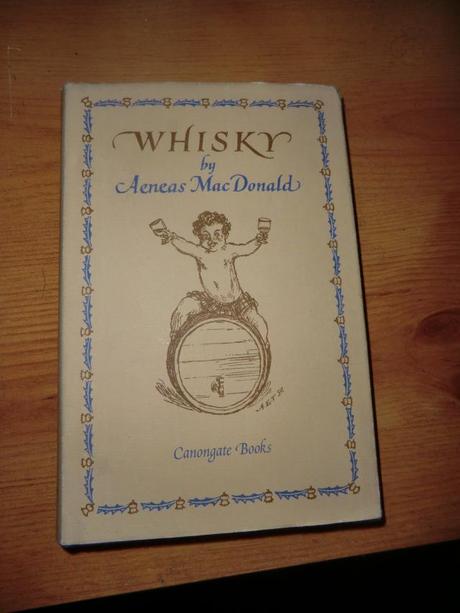
Whisky: Aeneas MacDonald (Canongate Books: ISBN 1 84195 857 3)
There are many books on Whisky out there, from photo filled doorsteps to pocket bibles of hundreds to thousands of whisky tastings.
Yet of them all, this little tome from 1930 is the one that I keep close to my heart. Its tasting notes are non existent. No photos. The data is most definitely not up to date. Yet it, more likely than any other, is to be the one to be slipped into a travel bag for any whisky trip.
Why?
There are many reasons, but the most important is enthusiasm. The writer shows a poetic love of the dram and its uses, from advice on tasting, searching for quality blends and malts, to use in food. In all cases he never couches his love or distaste with half felt words. This is seen from the opening where upon discussing those who drink wine to be fashionable he says
“In finding those qualities of bouquet and body which their textbooks bid them to seek, they are infallible, providing the bottle has been correctly labelled. They will, indeed, discover them before they have tasted the wine”
There is more to this book that such witty barbs, but I will admit they are a good part of the fun. There is more though, especially in the case of the timing of the writing of the book. Over 80 years old now the book is still, if only just, within living memory of our culture and is a ground level insight into the changes in the whisky scene over even such a small time.
The list of distilleries within is heartbreaking to a whisky fan in that it talks of many now long silent distillery, often with just the barest mention to hint at what we have lost. While the talk of now fallen Islay distilleries tug my heart strings, it is the reference to Campbeltown that we see the great fall, with the already dwindling at the time list of distilleries still far above what we have now. It was this book’s description of Campbeltowns as the “Double basses of the whisky orchestra” that first led me to the region. Here the book does show one of its flaws, as the distillery list is light on detail to allow covering of all the distilleries and I often wished it had taken more time to explain more about them, if only for posterity.
The book is filled with little comments, that would have been innocuous at the time, but now allow insight into another age of whisky. For even that alone the book is worth it. Some of the advice seems wonderful, but of uncertain use in present day. For example the advice to buy a small cask to fill with whisky and age, topping up and effectively vatting with new whisky as need be is one I would love to try, but I am unsure of sourcing such a thing these days.
The book has a rough history of Whisky, though far from the historians approach, but allows for a scattershot of tales and often wild extrapolations on the potential causes of events. It should not be treated as an academic document, but still includes many of my favorite tales including the oft repeated one of the gift of two pistols from the laird Abolour to the Glenlivet’s owner due to threats on his life for making his distillery one of the early ones to be legally registered.
Outside of the main text itself the book opens with an investigation into the true identity of the author behind the alias that is as interesting as the main writing itself. In contrast to the main text it is well sourced and referenced and gives an insight into the reasons and character of the writer which adds greatly to the enjoyment of the text.
As a reference text the book can seem weak, the tales give no hint to their source most of the time, the viewpoints of obvious bias, and oft full of supposition. To view the book on those values is I feel however to miss the point and the joy of the book.
This book is a polemic as much as anything else, a railing against the sullying of whisky with soda, against reducing it to the meagre use as an intoxicant and most importantly a call for whisky drinkers to experiment and educate themselves through experience rather than the words of another. As of such I highly approve.
If, by speaking so highly of it, I have caused a few fans of the fine spirit of Whisky to check this book out I will have considered my time as a blogger well spent. Even aged as it is it still stands as a manifesto to the enjoyment of whisky and should be held high.

